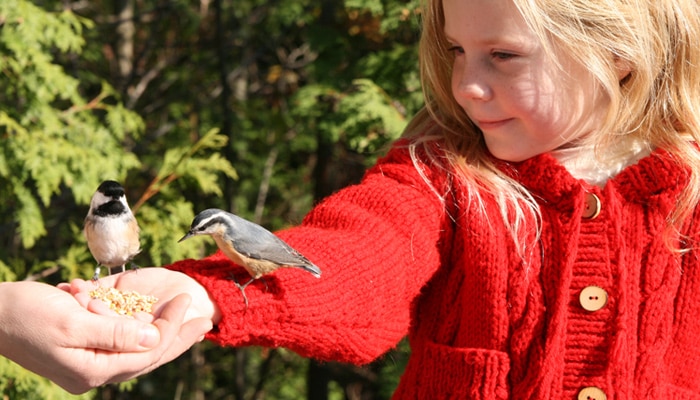While we believe that the books and resources recommended may be of value to you, keep in mind that these are suggestions only and you must do your own due diligence to determine whether the materials are appropriate and suitable for your use. PNC has no sponsorship or endorsement agreement with the authors or publishers of the materials listed.
RECYCLING

Bird Feeders
Children will reuse a milk container to conduct an experiment about what kind of food birds eat.

Lesson Objective
Children will reuse a plastic milk container, which is an item commonly used in their daily lives, to perform an experiment with birds native to their region.
Science
What You'll Need
- Clear plastic gallon milk or juice containers – 3 to 5 containers
- Birdseed – 5 pound bag
- Plain popped popcorn – about ½ gallon
- Stale bread – 1 loaf
- String – 1 ball
- Utility knife (for adult use only)
- Chart paper
- Permanent marker
What To Do
- Ask children open-ended questions about what they know about birds (see Guiding Student Inquiry). Record responses on chart paper.
- Explain that they will learn what birds like to eat. They will be helping birds and the environment by recycling plastic milk containers instead of throwing them in the trash.
- Make bird feeders by cutting a large window in the plastic jugs, opposite the handles. Make sure that there are no rough or sharp edges.
- Ask children for suggestions of what birds like to eat.
- Fill each feeder about half way with these different types of food – birdseed, popcorn, stale bread, and foods suggested by the children. Draw a line on the outside of the bird feeder to mark the height of the food.
- Ask the children, “How will we be able to tell which one of these foods the birds like best?”
- Hang your feeders outside where the children can view them from a window, or in an area where the children visit frequently, such as the playground.
- Over the next several days, watch the bird feeders to see which type of food is being consumed the fastest.
Resources
Home School Resources
Home educators: use these printable lesson PDFs to teach this lesson to your home schoolers. They're available in English and Spanish.
Content Provided By
Common Core State Standards Initiative – These lessons are aligned with the Common Core State Standards ("CCSS"). The CCSS provide a consistent, clear understanding of the concepts and skills children are expected to learn and guide teachers to provide their students with opportunities to gain these important skills and foundational knowledge [1]. Visit the CCSS


